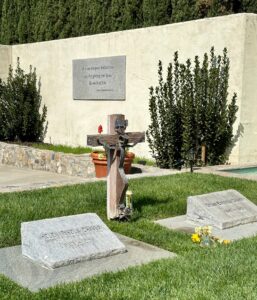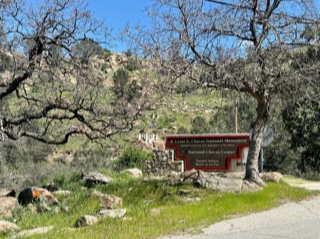Editor’s note: ChicoSol is reviving its Highway 99 series that was popular some 10 years ago to mark this year’s Cesar Chavez Day. State Route 99 cuts through California’s Central Valley, where union organizing had a tremendous impact.
by Lindajoy Fenley
posted March 27
The final resting place of Cesar Chavez, who led strikes to improve the lot of underpaid and disrespected farmworkers nationwide more than 50 years ago, has the peaceful moniker Nuestra Señora Reina de la Paz.

It has been headquarters of Chavez’s United Farm Workers union (UFW) since 1972 and a National Monument where the labor leader’s March 31 birthday has been celebrated annually since 2010. A warning sign that entry to the area is “impassable during high water” serves as a metaphor that the struggle for farmworker rights still faces challenges. Indeed, the bucolic spot tucked into the hills 30 miles east of Highway 99, a few miles before it merges into Interstate 5, is not immune from the controversy that marked Chavez’s life.
When the UFW purchased the 187-acres property in an auction in conservative Kern County in 1972, it had to hide its identity. The powerful agricultural community of the Central Valley did not like Chavez who, along with Dolores Huerta and Larry Itliong, had successfully led a nationwide grape strike and boycott in 1968. Two years earlier Chavez had led a 250-mile march from Delano to Sacramento to call attention to the plight of farmworkers.
At the height of activity at Nuestra Señora Reina de la Paz, more than 200 members of UFW families lived on the property, but now it is home to only a couple dozen people, according to Bernadette Farinas, Chavez’s granddaughter who works at the monument. Visitors come to learn about the farmworker movement from the museum, where they can see Chavez’s office, a model of a typical farmworker home and an extensive illustrated timeline of the organizer’s life.

Although widely revered today with many schools, streets and parks named after him, Chavez was a controversial figure when alive. His bold actions produced both friends and foes. Even after part of the UFW property became a national monument, security remains a concern.
Farinas recalls a man who carried an emotional burden when he visited several years ago. The man told her that when he was a boy, his father hated Cesar Chavez. So, he hated Chavez too without knowing why. This visitor sat for a long time to seek forgiveness at the gravesite where Chavez is buried next to his wife Helen. Soothing sounds from a water wall that flows into a reflection pond and the rumble of freight trains in the distance allow visitors like him a place for peace and quiet. Not far from the lawn-covered graves, potted flowers, cacti gardens and flowering pear trees add to the beauty.
This year, the Chavez birthday celebration will begin with a naturalization ceremony on Friday, March 29 and continue with mariachi music, folkloric dance and food through Sunday, March 31.
Lindajoy Fenley is part of the ChicoSol Advisory Group, a journalist, and a Spanish instructor.
